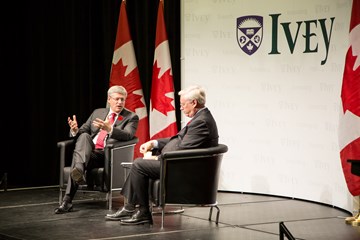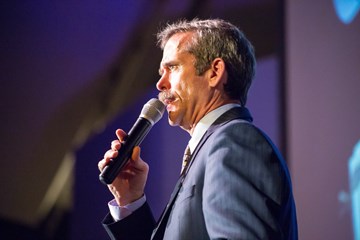Ivey HBA students have an “unbelievable opportunity” to help shape the conversation between government, business and indigenous people.
“Don’t ever take it for granted that things have to be organized in a certain way,” said Tanya Kappo, a citizen of the Sturgeon Lake Cree Nation who was involved in the Idle No More movement. “There are different ways of doing things and it doesn’t necessarily mean that one is right and one is wrong. I think as long as you keep that in mind, the conversation that we start, as difficult as it will be – and it will be difficult – (is one where) we can make progress.”
Fresh from a case study on the communications and social media strategies of Idle No More, students heard from Kappo and the The Honourable Bob Rae on several issues, including:
- How non-traditional native leadership comes together with traditional institutions, such as government and business;
- The transformation taking place among native peoples, including the movement to cities, the closer contact with native communities in resource rich areas; and, how Canadian law will give voice to their issues.
- How recent events, such as the death of Nelson Mandela, bring to light the comparison between the South African system of apartheid and Canada’s Indian Act.
Related to this story
We’ve captured some of the best quotes of the event:
Bob Rae on the connection between Canada and South Africa:
“Mandela speaks to us as Canadians. He doesn’t just speak to South Africans. He speaks to us as Canadians because of his dream of a rainbow country. His dream of a country that included everyone. His dream of a country that empowered everyone. This is a dream that applies to us as much as it applies to his country. And that’s something that we need to reflect on as we go forward and as we continue our conversation this morning and as you go forward with your studies.”
Tanya Kappo on the movement:
“In thinking about Idle No More as a movement and in trying to fit it into a paradigm that maybe makes some sense to you – in terms of leadership and organization – I couldn’t quite do it. I still can’t. The Idle No More movement is more or less a current embodiment of generations of struggle. So how it looks today is not how it looked for my parents and grandparents and it won’t be the same as how it looks for my children either.”
Bob Rae on what comes next:
“The questions now being posed to everyone on all sides of the equation are: ‘What exactly does this mean? How do we create these new partnerships? How do we give people a stake in the new economy?’ Idle No More is a complex movement. It’s a popular phenomenon. It’s outside the framework of The Indian Act. It’s outside the traditional power of the reserve system. It goes beyond traditional leadership, both in the non-indigenous and the indigenous population.”
Tanya Kappo on the future:
“When you think about leadership and communications, there is a valuable structure there for organizations, but also open your minds to think about other forms of leadership. I think when you move ahead in a way that’s more open-minded, it creates the space and the bigger opportunity for more people to be involved. Facing the kind of challenges that we face today with issues like the environment and the economy and what our priority is, and at what expense are we willing to go. We really have to start thinking ahead about our children and our grandchildren.”
The event was part of the Ian O. Ihnatowycz Institute for Leadership in the BMO Financial Group Auditorium.


